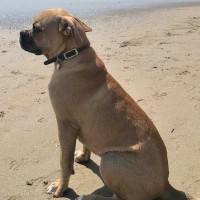Appearance of the American Pugabull
|
| There is no uniform color or marking pattern for the American Pugabull. However, often the Pugabull will be fawn in color, much like the average Pug, with black markings. The American Bulldog is available in a variety of colors: red brindle, white, red, brown, beige, fawn and piebald. It's likely that a Pugabull could come in any of these colors or color mixes. Both breeds are short-haired, and neither has a waterproof coat. Both breeds have medium softness and density. There is a clear difference in the size of each parent breed. The American Pugabull generally grows to the size of an English Bulldog and looks very much like a construction English. |
Temperament of the American Pugabull
|
| The Pug is a lively, friendly little dog. The American Bulldog is highly protective, loyal, courageous and alert. A mix of personalities would produce a loyal, active, courageous and friendly Pugabull. This hybrid may not be as active as the Pug, but it will always need daily mental and physical stimulation. The Pug can develop a behavioral condition known as small dog syndrome, which is not a behavioral problem born in the Pug but the result of human interaction with the Pug. The Pug needs to know that its master is the boss. Similarly, the American Bulldog needs a strong leader, otherwise he'll assume the role of pack leader. The Pugabull can inherit this pack leader mentality, so it's important to be firm but consistent with the Pugabull. |
Needs and activities of the American Pugabull
|
| The American Bulldog is a very active dog, however, when kept indoors, it can become relatively inactive, especially in old age. The Pug is an excellent indoor dog, as it doesn't require much exercise. However, both parent breeds are prone to mischief without proper activity. Because the Pug is naturally brachycephalic, it's best not to leave the Pugabull outside for long periods unsupervised. Brachycephalic dogs can't overheat, so when exercising your American Pugabull, be careful. |
Maintenance of the American Pugabull
|
| Although the American Bulldog is only an average shedder, the Pug sheds constantly, so it's reasonable to expect the Pugabull to be an average, if not above-average, shedder. Both parent breeds have short coats. We recommend brushing your Pugabull every week, more if it's shedding season. Bathe your Pugabull only when necessary. Teeth should be brushed at least three times a week, but daily brushing will help prevent tooth decay and bad breath. Nails should be trimmed twice a month. If you hear your dog's nails clicking on the floor, they need trimming. It's a good idea to start grooming your puppy at an early age, so he can get used to a routine. |









 English (United Kingdom)
English (United Kingdom)